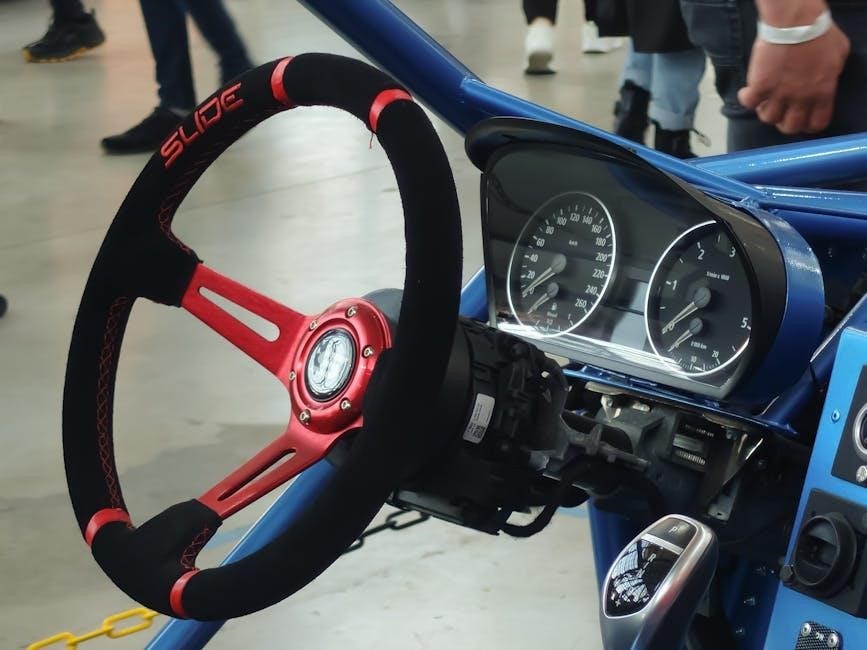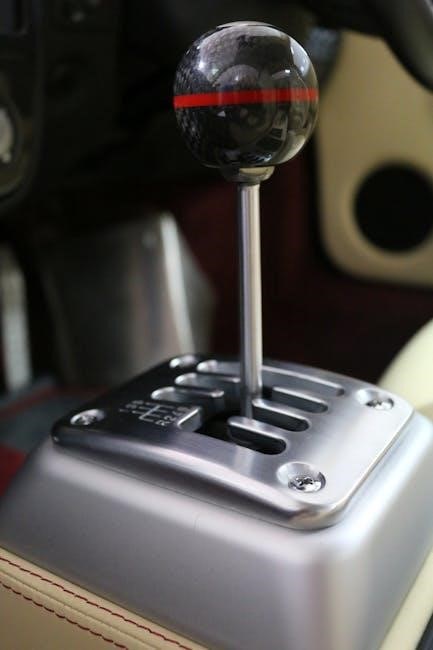Manual shifting in the 4L60E transmission offers enhanced driver control and performance. Designed as an automatic, it can be modified for manual operation, appealing to enthusiasts seeking improved torque delivery and gear selection. This process involves upgrading components like shift kits and valve bodies, allowing drivers to override automatic functions for precise shifting. While it requires technical expertise, manual shifting can optimize power and responsiveness, especially in high-performance scenarios.
1.1 Overview of Manual Shifting
Manual shifting in the 4L60E transmission involves overriding its automatic functions to control gear changes manually. This is achieved through modifications such as installing a mechanical shift kit and a manual valve body, which enable precise gear selection. Enthusiasts often pursue this for enhanced control and performance, particularly in high-torque applications. However, manual shifting requires careful setup, including adjustments to servo release check balls and throttle position sensors for smooth operation. Common issues include delayed shifting between gears and failure to engage first gear when cold, often linked to worn components like the low/reverse valve. Proper modifications and maintenance are essential for reliable operation and optimal performance.
1.2 Benefits of Manual Shifting in the 4L60E
Manual shifting in the 4L60E transmission offers several advantages, particularly for performance enthusiasts. It provides direct control over gear selection, allowing drivers to optimize power delivery and torque output. This is especially beneficial in high-performance or racing scenarios, where precise control over shifts can significantly improve acceleration and responsiveness. Manual shifting also enables drivers to hold gears longer, preventing unwanted upshifts that can reduce power during critical moments. Additionally, it enhances driver engagement by allowing for a more interactive driving experience. While manual shifting requires specific modifications, such as a mechanical shift kit and manual valve body, the benefits in terms of performance and control make it a popular choice among those seeking to maximize their transmission’s potential.

Understanding the Components of the 4L60E Transmission
The 4L60E transmission relies on key components like the shift kit, manual valve body, servo, and TPS to enable precise control during manual shifting operations.
2.1 The Role of the Shift Kit in Manual Shifting
The shift kit plays a crucial role in enabling manual shifting in the 4L60E transmission. It modifies the transmission’s valving to prevent unwanted automatic shifts, allowing precise gear selection. A Stage 2 shift kit is essential for manual operation, as it enables selecting any gear manually. This kit includes components that enhance clutch pack engagement and improve shift timing. However, installing only a shift kit without a manual valve body may not achieve full manual control. The shift kit works by altering hydraulic pressure within the transmission, ensuring gears engage as directed by the driver. This setup is particularly popular among enthusiasts seeking better performance and control. Proper installation is critical to avoid issues like delayed shifts or failed engagements, especially when the transmission is cold.
2.2 Manual Valve Body: What It Is and Why It Matters
A manual valve body is a critical component for achieving full manual control in the 4L60E transmission. Unlike the stock valve body, which relies on electronic controls and solenoids, a manual valve body allows the driver to directly control gear shifts without automatic intervention. This setup eliminates the torque converter clutch (TCC) and other automatic features, making it ideal for racing or high-performance applications. The manual valve body operates using a dedicated manual shift mechanism, ensuring precise gear engagement. It also enhances shift feel and reliability under heavy stress. However, installing a manual valve body requires a mechanical shift kit and often necessitates custom setup and tuning. This component is essential for enthusiasts seeking complete control over their transmission’s behavior.
2.3 Servo and Valve Issues in Manual Shifting
Servo and valve issues are common challenges when manually shifting the 4L60E. The servo assembly, responsible for applying pressure to the bands, can wear out over time, leading to delayed or incomplete shifts. Similarly, the valve system, which directs hydraulic fluid to engage gears, can malfunction due to debris or worn seals. These problems often result in poor shift quality, such as slipping or slow engagement. Upgrading to high-performance servos and valves can address these issues. Additionally, ensuring proper hydraulic pressure and clean fluid is crucial for optimal operation. Addressing these components is essential for smooth, reliable manual shifting in the 4L60E transmission.
2.4 The Importance of the Throttle Position Sensor (TPS)
The Throttle Position Sensor (TPS) plays a critical role in manual shifting of the 4L60E transmission. The TPS provides real-time data about the throttle pedal’s position, which the transmission control module uses to determine shift timing and firmness. Accurate TPS feedback ensures smooth and precise gear changes, especially when manually shifting. A faulty or misadjusted TPS can lead to erratic shifting, poor performance, and increased wear on transmission components. Proper calibration and maintenance of the TPS are essential for optimal manual shifting. It helps the transmission adapt to driving conditions and maintain control over gear engagement, making it a vital component for both automatic and manual shifting modes in the 4L60E.

The Process of Manual Shifting in the 4L60E
Manual shifting in the 4L60E involves using a selector switch or manual controls to engage gears, bypassing automatic shift logic for driver-commanded shifts, enhancing control and performance.
3.1 Step-by-Step Guide to Manual Shifting
Manual shifting the 4L60E requires precise control and understanding of its operation. Start by selecting manual mode via the Performance Mode Switch, disabling automatic shifting. Use the manual selector to choose gears, ensuring smooth transitions between First, Second, Third, and Fourth gears. Apply gentle throttle input when shifting to avoid abrupt engagement. Monitor the tachometer to determine optimal shift points, typically around 2,500-3,000 RPM for upshifts. Downshift before braking to maintain control and reduce wear on the brakes. Always ensure the transmission is at operating temperature before aggressive driving. Avoid riding the clutch or brake excessively, as this can cause unnecessary strain on internal components. Regularly check fluid levels and condition to maintain optimal performance and longevity of the transmission. Proper technique ensures reliability and enhances driving experience.
3.2 The Role of the Performance Mode Switch
The Performance Mode Switch is a critical component for manual shifting in the 4L60E, enabling drivers to toggle between automatic and manual control. Activating this switch allows the transmission to prioritize driver input, delivering precise gear shifts and enhanced control during performance driving. It bypasses the automatic shifting logic, ensuring the transmission holds the selected gear until manually changed. This feature is particularly useful for racing or towing scenarios, where predictable gear engagement is essential. The switch prevents unintended shifts, providing stability and reliability under heavy loads or high-stress conditions. Proper use of the Performance Mode Switch enhances acceleration, torque delivery, and overall drivetrain responsiveness, making it a vital tool for drivers seeking manual control over the 4L60E transmission.
3.3 Setting Up Performance Tables for Manual Control
Setting up performance tables for manual control in the 4L60E involves configuring specific parameters to optimize gear shifts and torque delivery. These tables define how the transmission responds to throttle input, load, and RPM, ensuring precise control during manual shifting. Key adjustments include modifying shift points, shift firmness, and torque converter engagement. Tuning software allows drivers to customize these settings based on their driving style or vehicle setup. Properly calibrated tables enhance acceleration, reduce slippage, and improve overall performance. Adjustments should be made cautiously, as incorrect settings can lead to poor transmission behavior. Expertise or specialized tools may be required to fine-tune these tables effectively, ensuring reliable and responsive manual shifting in various driving conditions. This step is crucial for maximizing the potential of manual control in the 4L60E transmission.

Benefits of Manual Shifting
Manual shifting in the 4L60E enhances driver control, improves performance, and ensures precise gear engagement, making it ideal for racing and high-performance driving scenarios.
4.1 Increased Control Over Gear Selection
Manual shifting in the 4L60E provides drivers with direct control over gear selection, allowing precise command of the transmission’s behavior. This is particularly beneficial in scenarios where automatic shifting may not be optimal, such as towing heavy loads or navigating steep inclines. By manually selecting gears, drivers can maintain the desired torque and speed, ensuring better performance and efficiency. The ability to hold gears during acceleration or downshift for engine braking enhances driving dynamics, especially in racing or performance driving. This level of control also reduces reliance on the automatic system, which can sometimes hesitate or select inappropriate gears. As a result, manual shifting delivers a more engaging and responsive driving experience, making it a preferred choice for enthusiasts seeking enhanced vehicle command.
4.2 Improved Performance and Torque Delivery
Manual shifting in the 4L60E enhances performance and torque delivery by enabling precise gear engagement tailored to driving conditions. This eliminates unnecessary shifts, reducing power loss during acceleration. By holding gears in optimal RPM ranges, the engine maintains peak torque output, resulting in quicker acceleration and improved responsiveness. In high-performance scenarios, such as racing or heavy towing, manual control ensures the transmission operates efficiently, delivering consistent power without hesitation. This level of control minimizes slippage and keeps the transmission in the correct gear for the task, maximizing both performance and efficiency. The result is a more dynamic and responsive driving experience, especially in demanding situations where automatic shifting may falter. Manual shifting thus becomes a key tool for drivers seeking enhanced vehicle performance and reliability.

Challenges and Considerations
Manual shifting the 4L60E introduces complexity, requiring precise control and adjustments. It demands mechanical expertise and can lead to increased wear on transmission components over time.
5.1 Mechanical Complexity of Full Manualization
Manual shifting the 4L60E requires significant mechanical modifications, as the transmission is designed for automatic operation. Full manualization involves replacing or reprogramming key components, such as the valve body and shift kit, to enable driver-controlled gear changes; This process demands precise adjustments to ensure smooth and reliable shifting. The mechanical complexity increases the risk of errors during installation, which can lead to poor performance or even transmission damage. Additionally, the driver must develop the skill to manually shift gears effectively, as improper techniques can strain the system. Specialized tools and technical expertise are essential for a successful setup, making it less accessible to DIY enthusiasts without experience. The long-term reliability of the transmission also depends on the quality of these modifications.
5.2 Potential for Increased Wear on Transmission Components
Manual shifting the 4L60E can lead to increased wear on transmission components due to the additional stress placed on the system. Constant manual control over gear changes can cause excessive friction and heat buildup, particularly in the clutch packs and bands. The torque converter, servo, and valve body are also subjected to higher mechanical demands, accelerating wear. Aggressive shifting practices, such as rapid gear changes or riding the brakes, can further exacerbate this issue. Over time, this can result in premature failure of critical components, requiring costly repairs. Drivers must balance the benefits of manual control with the need to maintain transmission longevity. Proper technique and regular maintenance are crucial to mitigate these risks and ensure long-term reliability.

Common Issues with Manual Shifting
Manual shifting in the 4L60E can lead to issues like erratic gear behavior, delayed engagement, or hard shifting due to improper setup or component wear.
6.1 Delayed Shifting Between Gears
Delayed shifting in the 4L60E transmission during manual operation can be caused by several factors, including worn or improperly adjusted shift kits, faulty throttle position sensors, or issues with the vacuum modulator. Old or incorrect transmission fluid can also lead to delayed engagement, as it may not provide adequate pressure for clutch packs and bands to engage promptly. Additionally, problems with the servo or valve body, such as worn components or faulty solenoids, can disrupt the timing of gear changes. A clogged transmission filter may further exacerbate the issue by restricting fluid flow. Addressing these potential causes systematically, starting with fluid checks and moving to more complex components, is essential to resolve the delay and ensure smooth manual shifting.
6.2 Failure to Engage First Gear When Cold
Failure to engage first gear when cold in a manually shifted 4L60E transmission is often linked to low transmission fluid pressure or a malfunctioning valve body. Cold temperatures can cause the fluid to thicken, reducing its ability to flow quickly through the hydraulic circuits. A worn or stuck low/reverse valve, or a faulty servo, can prevent the clutch pack from engaging properly. Additionally, a malfunctioning throttle position sensor (TPS) may send incorrect signals, disrupting the transmission’s ability to engage gears. In some cases, the clutch pack itself may be worn, requiring replacement. Checking the fluid level when cold, inspecting the valve body, and ensuring proper servo operation are critical steps to resolve this issue and restore reliable first-gear engagement.
6.3 Hard or Abrupt Shifting
Hard or abrupt shifting in a manually shifted 4L60E transmission can be caused by excessive line pressure, a malfunctioning manual valve body, or worn-out shift kit components. When the valve body is not calibrated correctly, it can lead to sudden, harsh gear engagements. Similarly, a high-performance shift kit with overly aggressive springs may result in abrupt shifts. Additionally, a faulty servo or improper adjustment of the servo release check ball can exacerbate the issue. To address this, it’s essential to ensure the shift kit is installed correctly and that the valve body is recalibrated for smooth operation. Adjusting the line pressure and replacing worn components can also help eliminate harsh shifting and improve overall transmission performance.
6.4 Problems with Reverse Gear Engagement
Issues with reverse gear engagement in a manually shifted 4L60E transmission often stem from problems with the Low/Reverse valve or the manual valve body setup. A worn or clogged Low/Reverse valve can prevent proper fluid flow, leading to delayed or failed engagement of reverse gear. Additionally, incorrect wiring or programming of the Transmission Control Module (TCM) can disrupt the electronic signals required for reverse gear activation. Misalignment of the manual shift mechanism or a faulty Throttle Position Sensor (TPS) can also contribute to erratic behavior. Regular maintenance, such as cleaning or replacing the Low/Reverse valve and ensuring proper alignment of the manual controls, can help resolve these issues. Addressing these problems is critical for smooth and reliable operation of the transmission in both forward and reverse gears.

Solutions for Common Issues
Upgrading to performance shift kits and manual valve bodies often resolves shifting problems. Adjusting the servo release check ball and replacing worn components ensures proper gear engagement. Regular fluid changes and filter replacements maintain optimal transmission health, preventing issues and enhancing control.

7.1 Upgrading to a Stage 2 or Stage 3 Shift Kit
Upgrading to a Stage 2 or Stage 3 shift kit enhances the 4L60E’s performance by improving shift firmness and reducing wear. These kits include modified valve and servo components designed to handle increased power and torque. Stage 2 kits are ideal for mild performance applications, while Stage 3 kits are built for heavy-duty use. Both stages improve low-end acceleration and reduce slippage during gear changes. Installing a performance shift kit requires careful calibration to ensure proper function. This upgrade is particularly beneficial for manual shifting, as it provides crisper, more responsive gear engagement. It’s a cost-effective solution to common issues like delayed or erratic shifting, making it a popular choice for drivers seeking improved control and reliability.
7.2 Installing a Mechanical Shift Kit and Manual Valve Body
Installing a mechanical shift kit and manual valve body provides full control over gear shifts, eliminating reliance on the transmission’s governor. This setup is ideal for drivers seeking precise, manual operation. The mechanical shift kit replaces the stock components with heavy-duty parts designed for durability and performance. The manual valve body bypasses the automatic functions, allowing direct control through the shifter. This modification is particularly beneficial for racing or high-performance applications, where quick, consistent shifts are critical. It requires careful installation and calibration to ensure proper function. Once installed, drivers can enjoy improved control and precision shifting, making it a popular choice for those who demand the highest level of transmission performance and reliability.
7.3 Adjusting the Servo Release Check Ball
Adjusting the servo release check ball is crucial for ensuring smooth and precise manual shifting in the 4L60E. This component controls the servo’s release pressure, directly affecting gear engagement and disengagement. Proper adjustment prevents issues like delayed shifts or abrupt engagement. To adjust, use a check ball tool to measure and set the release pressure according to specifications. Incorrect settings can lead to hard shifting or hesitation. This adjustment ensures consistent and reliable performance during manual operation. Regular inspection and adjustment are recommended to maintain optimal transmission function and prevent potential damage to servo and valve components. Proper setup guarantees smoother shifts and enhanced control over the transmission’s behavior under various driving conditions.

7.4 Replacing the Low/Reverse Valve
Replacing the low/reverse valve is essential for resolving issues like failed reverse engagement or hard shifting into low gear. This valve is critical for directing fluid pressure to engage reverse or low gear. Over time, wear or contamination can cause it to malfunction. To replace it, access the valve body, remove the faulty valve, and install a new one. Use genuine GM parts or high-quality aftermarket components for reliability. Proper installation ensures smooth engagement of reverse and low gears. This fix addresses common manual shifting problems and restores transmission functionality. Regular maintenance and inspections can prevent such issues. Always use the correct tools and follow proper procedures to avoid further damage.

Tools and Maintenance for Manual Shifting
Essential tools include a scan tool, pressure gauge, and rebuild kit. Regular fluid changes, filter replacements, and inspecting solenoids ensure smooth operation and prevent premature wear.
8.1 Essential Tools for Manual Shifting Setup
Setting up manual shifting in the 4L60E requires specific tools. A scan tool is essential for monitoring transmission performance and troubleshooting issues. A transmission pressure gauge helps verify line pressure, ensuring proper engagement. A rebuild kit is necessary for replacing worn components like seals and gaskets. A torque wrench is needed for precise bolt tightening, while a deep socket set aids in accessing hard-to-reach bolts. Additionally, a solenoid tester is useful for diagnosing electrical issues, and a pan gasket is required when replacing the transmission pan. Lastly, lubricants, such as ATF and hydraulic fluid, are critical for maintaining smooth operation. These tools ensure a successful manual shifting setup and long-term reliability.
8.2 Maintenance Tips for Long-Term Reliability
Regular maintenance is crucial for ensuring long-term reliability when manually shifting the 4L60E. Start by performing routine fluid changes using high-quality ATF to maintain optimal transmission health. Replace the transmission filter every 30,000 miles to prevent debris buildup. Inspect the pan gasket and seals for leaks, addressing them promptly to avoid internal damage. Monitor transmission temperature with a gauge, especially during heavy use, to prevent overheating. Regularly inspect and tighten the shifter and linkage connections to maintain precise control. Adjust the shift kit as needed to ensure smooth engagement. Finally, use a scan tool to check for error codes and address any issues early. These practices will help extend the life of your manually shifted 4L60E.
Manual shifting the 4L60E offers enhanced control, performance, and reliability for enthusiasts. Proper setup and maintenance are key to maximizing its potential and longevity.
9.1 Final Thoughts on Manual Shifting the 4L60E
Manual shifting the 4L60E is a rewarding yet complex modification that enhances driver control and performance. It requires careful setup, maintenance, and understanding of transmission dynamics. While it offers improved torque delivery and responsiveness, the mechanical demands and potential wear on components must be considered. For enthusiasts seeking precision and power, manual shifting can be a game-changer, especially in racing or high-performance scenarios. However, proper installation and tuning are critical to avoid complications. With the right tools and knowledge, manual shifting can elevate the 4L60E’s capabilities, making it a viable choice for those willing to invest time and effort into mastering this advanced technique.
9.2 Tips for Successful Manual Shifting
To achieve successful manual shifting in the 4L60E, practice smooth and deliberate gear changes, especially during acceleration. Use the throttle position sensor (TPS) to monitor load and adjust shifts accordingly. Avoid abrupt movements, as they can strain internal components. Regularly inspect and maintain the shift linkage, servo, and valve body to ensure proper engagement. Always use the correct transmission fluid and filter to maintain optimal performance. Keep an eye on transmission temperature, especially in high-stress conditions. Fine-tune the shift kit and valve body settings to match your driving style and vehicle setup. Lastly, stay attentive to gear engagement feedback to refine your technique over time. Consistency and patience are key to mastering manual shifting effectively.
